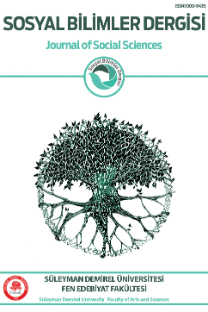Isparta müzesi'ndeki yerel stilde bazı roma dönemi mezar stelleri
Isparta Müzesinde Isparta ve ilçeleri yakınlarındaki antik yerleşmelerden ele geçmiş çok sayıda mezar steli ve adak kabartması bulunmaktadır. Bu eserler kireçtaşından yapılmış olup malzemesi eserin yapıldığı bölgeye en yakın yerden elde edildiğinden, bu bölgenin Roma Dönemindeki yerel sanat üretimi, tercih edilen konuları ve yerel işlikleri hakkında bize bilgi sunmaktadır. Bu gözlemden hareketle Konane yüzey araştırmaları sırasında bulunmuş iki mezar kabartması ve Aksu ilçesi Sofular Köyünde ele geçen bir mezar steli örnek alınarak Kuzey Pisidiada taşra stili ve tarihleme sorunları üzerine düşünceler dile getirilecektir. Farklı kompozisyon ve tipte olmalarına karşın bu üç mezar kabartmasının ortak özelliği, alt gelir grubuna ait insanlara ait olması ve onurlandırma heykellerine gönderme yapmasıdır. Antik Dönemde bir geçiş bölgesi olan Isparta ve çevresinde Roma Döneminde üretilen kabartmalarda da antik yerleşmelere göre farklılaşmaların olduğunu görmekteyiz. Bu bölgede belli bir antik yerleşmede belli bir mezar steli formunun ve kompozisyon biçiminin tercih edildiği, bu şekilde diğerlerinden ayrıldığı diğer bir gözlemdir.
Local style grave stelae from ımperial period at the museum of Isparta
In the Museum of Isparta there are numerous grave and votive stelae that come from ancient settlements near the present city of Isparta and its wider area. All these works are of limestone, quarried locally. The stelae thus provide information about local workshops,about favorite topics and about regional artistic production in Roman Imperial period. Based on three grave steles, two of which were found at the 'Konane Survey' and one in the village Sofular, district Aksu, problems of dating are discussed and some observations about the provincial style of Northern Pisidia are madein the following. Although each of the three grave reliefs differ in frame structure and type they share common characteristics:They were built for low-income people and allusions to honorary statues there are to be found. In antiquity, the area of Isparta was a transition zone; grave stelae from the imperial period differ in form and depiction locally from each other.
___
- AYTAÇLAR, P. Ö., Yazıtlar ve Antik Kaynaklar Işığında Batı Anadoluda Entellektüeller, Ege Yayınları, Istanbul, 2006.
- DREW-BEAR, T., LOCHMANN, T., Grabreliefs aus Amorion, Orkistos und der Antiken Siedlung von Bağlıca. Zeugen verlorengegangener Grabbauten, Arkeoloji Dergisi, 4, 1996, 109 -134.
- EULE, C., Hellenistische Bürgerinnen aus Kleinasien. Weibliche Gewandstatuen in ihrem antiken Kontext, TASK, Istanbul, 2001.
- HÜRMÜZLÜ, B., Pisidiada Gömü Geleneklerinin Işığında Kültürler Arası İlişkiler, SDÜ Fen-Edebiyat Fakültesi Sosyal Bilimler Dergisi,15, 2007,1-22.
- HÜRMÜZLÜ, B., Isparta Arkeolojik Surveyi 2010 çalışmaları: Konane (Conana), 29. Araştırma Sonuçları Toplantısı Cilt I., Ankara 2012, 1-10.
- IVERSEN, P., Inscriptions from Pisidian Konane (Conana) and the Surrounding Area, Epigraphica Anatolica 45, 2012, 103-152.
- KELP, U., Das Phänomen der Türfassaden in Phrygien. Zu lokalen Identitäten anhand einiger Grabtypen römischer Zeit, Elmar Schwertheim Engelbert Winter (eds.), Neue Funde und Forschungen in Phrygien (=Asia Minor Studien Bd. 61), R. Habelt, Bonn, 2008, 69-91.
- KELP, U., Grave monuments and local identities in Roman Phrygia, Peter Thonemann (ed.), Roman Phrygia, Cambridge University Press, Cambridge, 2013, 70-94.
- KNELL, H., Architektur der Griechen, Wissenschaftliche Buchgesellschaft, Darmstadt, 1998.
- LOCHMAN, T., Eine Gruppe spätrömischer Grabsteine aus Phrygien, Ernst Berger (ed.), Antike Kunstwerke der Sammlung III, Zabern, Mainz am Rhein, 1990, 453-508.
- LOCHMAN, T., Studien zu kaiserzeitlichen Grab- und Votivreliefs aus Phrygien (Basel: Skulpturhalle Basel), Basel, 2003.
- MA, J., Statues and Cities: Honorific Portraits and Civic Identity in the Hellenistic World (Oxford Studies in Ancient Culture and Representation), Oxford University Press, Oxford, 2013.
- MOOCK, W., Die figürlichen Grabstelen Attikas in der Kaiserzeit, Zabern, Mainz am Rhein, 1998.
- PİNKWART, D., Weibliche Gewandstatuen aus Magnesia am Mäander, Antike Plastik 12, 1973, 149-160.
- SCHMALTZ, B., Griechische Grabreliefs. Wissenschaftliche Buchgesellschaft Darmstadt 1983.
- SINN, F., Reliefs, Altäre, Urnen, Museo Gregoriano Profano ex Lateranense, Katalog der Skulpturen 1, MAR 17, Zabern, Mainz am Rhein,1991.
- STEMMER, K., Kontext und Funktion antiker Skulptur, Ausstellungskatalog Berlin, Berlin 1995.
- ŞAHİN, M., Miletopolis kökenli figürlü Mezar Stelleri ve Adak Levhaları, TTK Yayınları, Ankara 2000.
- WAELKENS, M., Phrygian Votive and Tombstones as Sources of the Social and Economic Life in Roman Antiquity, Ancient Society 8, 1977, 277-325.
- WAELKENS, M., Die kleinasiatischen Türsteine. Typologische und epigraphische Untersuchungen der kleinasiatischen Grabreliefs mit Scheintür, Zabern, Mainz am Rhein,1986.
- ISSN: 1300-9435
- Yayın Aralığı: Yılda 3 Sayı
- Başlangıç: 1995
- Yayıncı: Süleyman Demirel Üniversitesi, Fen-Edebiyat Fakültesi
Sayıdaki Diğer Makaleler
Belgrad kalesi'nde tamir ve imar faaliyetleri (1740-1743)
Isparta'da bulunan beş karamanlıca kitabenin incelenmesi
Konu hadisleri bağlamında Hz. Peygamber'in kabrini ziyaret
Isparta müzesi'ndeki yerel stilde bazı roma dönemi mezar stelleri
Serbest Cumhuriyet fırkası'nın kurulması ve Cumhuriyet halk fırkası'nın gelişmelere bakışı
